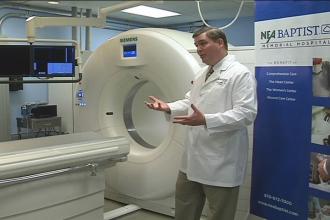News Taffy
| Post Your News Send Us An Event Start A Gallery |  |
| Most Recent | Most Popular | Top Contributors | Galleries | Events |
News Article
 | Contributor: jennifer.martinez subscribe to my stories |
 NEA Baptist Memorial Hospital announces the installation of the first dual source CT scanner in the state of Arkansas. NEA Baptist Memorial Hospital announces the installation of the first dual source CT scanner in the state of Arkansas. The Siemens Somatom Definition Flash CT scanner is 1 of only 43 in the United States and 150 in the world. The new scanner can capture incredibly detailed images of the heart, brain, bones—even the smallest blood vessels. This kind of speed is unprecedented and utilizes the lowest radiation exposures. NEA Baptist Health System is pleased to bring the fastest, safest and most technological diagnostic CT scanner to Jonesboro. The scanner's two x-ray tubes and two detector rows combine to make it the world's fastest scanner. The aptly named Flash provides a scanning speed of 43 centimeters per second, enabled by a gantry that rotates about its own axis in just 0.28 seconds. It can scan the entire body in less than six seconds and image the chest in 0.6 seconds. Thus, sick patients don’t have to hold their breath during chest scans. This speed provides significant advantages when imaging older patients and children, as well emergency department and intensive care unit patients. "Patient safety is the most important thing at our hospital," says Dr. John Phillips radiologist-in-chief. The scanner uses two separate x-ray beams to minimize the radiation exposure to the patient and the length of the exam. A traditional CT scan of the chest requires about 20 millisievert of radiation. This machine can do it with about 1 millisievert. One high energy and one low energy x-ray tube used with the X-CARE application can selectively reduce exposure. “With this, we decrease x-ray exposure to sensitive organs, such as the female breast or the thyroid, by about 40%,” says Phillips. This is done by a simple yet effective technique, he explains. During the tube rotation around the patient, the x-ray tube is switched off when the tube is directly in front of a sensitive organ. “As soon as the tube comes behind the patient, it turns on again and continues collecting data. This is possible due to some very advanced radiation protection software and incredible computer processing power in the $ 2 million machine.”Until now, patients would have to travel to St. Louis, Mayo Clinic, or Dallas for this technology. In addition to speed and low dose the application of a dual energy system results in tissue characterization that is phenomenal. The scanner exposes tissue to both high and low energy radiation. Based on the response the computer can determine the composition of the tissue imaged. This is done at no increased dose. No other scanner in Arkansas has this ability. These dual energy applications include the following:Advanced CT angiography. This machine has the ability to automatically remove bone and calcified plaque to see the arteries in greater detail. This is very useful in stroke patient evaluation, aneurysm cases and after endograft repair of aneurysms.Better blood clot detection. The machine can actually detect areas in the lung that don't receive enough blood flow. This can help doctors detect pulmonary emboli more commonly known as blood clots of the lungs.Contrast optimization. Focusing on the low energy tube makes contrast brighter. This allows the radiologist to administer less x-ray dye. This is important to patients with kidney problems.Kidney stone characterization. The machine's computer can actually determine if kidney stones contain uric acid. Uric acid stones are treated with medication. Calcium containing stones may be treated with surgery or lithotripsy.Diagnosis of gout. In patients with arthritis the machine can actually identify uric acid collections diagnosing gouty arthritis.The world’s fastest examination of the heart. Since the heart is beating the ability to obtain good pictures with a CT scan can be very challenging. This machine can spin around the patient in one fourth of the second essentially stopping the heart in space for a picture.Virtual noncontrast imaging. Without a dual energy scanner, many times the patient will receive a CT scan without contrast dye enhancement and then the study would be repeated with intravenous dye. The images after dye are called "enhanced images". With the Flash scanner the patient can frequently be scanned one time with dye. Then, the computer can subtract away the dye providing the radiologist with unenhanced and enhanced images of the body organs. However, the radiation dose is exactly 50% of the traditional method.Better lung cancer and lung nodule characterization. Using dual-energy technology it is possible to very accurately determine the vascularity of lung nodules helping doctors predict the probability of malignancy within a given nodule. NEA Baptist Memorial Hospital is a 100-bed acute care facility in Jonesboro. The hospital offers a number of inpatient and outpatient services, including an emergency room, surgical services, neurology, respiratory care, cancer care and pulmonary rehabilitation. NEA Baptist Memorial also offers heart care through its Heart Center and labor and delivery services through the hospital’s Women’s Center. For more information about NEA Baptist Memorial Hospital, please call 870-972-7000 or visit www.neabaptist.com.
[+] add comment |














